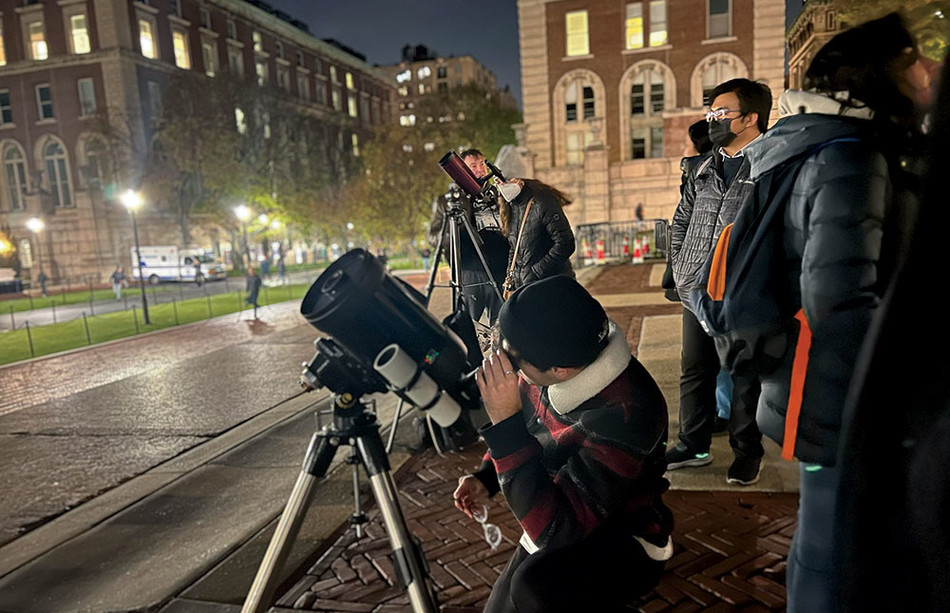The universe is bigger than ever. You could even say it’s blowing up. Certainly it is expanding — and so, too, is the age-old human fascination: What’s out there? Who’s out there? How did it all begin? This boom in interest, reflected in the dramatic spike in telescope sales during the pandemic, has been fueled by recent headlines: the exploits of the Mars rover Curiosity (which has discovered, among other things, traces of organic compounds in Martian rock); NASA’s plan to return astronauts to the lunar surface; and the celestial fireworks captured by the James Webb Space Telescope (JWST), which was launched in December 2021 and has since detected light from thousands of previously unknown galaxies containing millions of billions of stars, the baby pictures of a universe thought to be 13.7 billion years old.
If the mysteries of space stretch the limits of human comprehension, there is, in the constellation of upper Broadway, a beacon for those in search of answers: Columbia Astronomy Public Outreach, a student-run program that offers free lectures and events to the community.
Overseen for the past decade by professor Marcel Agüeros ’96CC, the group includes PhD candidate Ryan Golant and undergrads Selina Yang, Aiden Cloud, Albert Zhang, and Matthew Werneken, who organize space-based events drawing hundreds of people. Earlier this year, in Pupin Hall, Amanda Quirk ’17CC, a Columbia Science Fellow, lectured on the Triangulum Galaxy, one of the so-called Local Group of more than thirty galaxies that includes our Milky Way; PhD student Shifra Mandel ’19GS spoke on the death of stars; and professor David Helfand, who has taught at Columbia for more than forty years, interpreted the far-out findings of the JWST. The talks are typically followed by a stargazing session, either in the Rutherfurd Observatory on the Pupin roof or with smaller telescopes on College Walk.
For Selina Yang, an astrophysics major, the lure of space is inescapably romantic. “That’s what got me into astronomy: this idea that we come from the dust of the stars,” Yang says. “For me, astronomers are the people who take the biggest existential questions in their lives — beautiful, romantic, philosophical questions — and answer them in the hardest way possible.”
Such starry enchantment can be contagious, and Golant plans to spread the magic dust by sending grad students to speak at local schools and by restoring the pre-COVID-19 public stargazing program, founded in 2006 by Cameron Hummels ’12GSAS, in which Columbia students set up telescopes on 125th Street and Adam Clayton Powell Jr. Boulevard, affording passersby close-ups of the planets and the moon. “As astronomers, it’s our responsibility to talk to the public,” says Kathryn Johnston, a professor of astronomy at Columbia and the program’s faculty adviser this year. “We see this as part of our students’ training.”
There are many pathways to the stars. Johnston was captivated as a teen by The Collapsing Universe: The Story of Black Holes, by Isaac Asimov ’39GS, ’41GSAS, ’83HON, which explained how concentrations of matter in space exert such powerful gravity that light cannot escape them. For Hummels, now a research scientist and director of astrophysics outreach at Caltech, the hook was his early exposure to telescopes through a local amateur astronomy group. “That’s part of why I’m passionate about public education,” he says. “I think our society would be improved if everyone had a basic understanding of science, a healthy skepticism when faced with new claims, and the tools to test and verify things methodically.”
At David Helfand’s talk on the JWST — the largest, most powerful telescope ever hurled into the void — attendees heard the musings of a master. Noting that human vision is sensitive only to “a tiny fraction of the entire electromagnetic spectrum” and that “we are observing the universe effectively blind,” Helfand explained that the Hubble Space Telescope — JWST’s famed predecessor — was designed to study stars mainly in the visible spectrum. “However,” Helfand said, “the universe has been expanding for a long time, and as light travels through it, this great space through which it’s traveling is stretching, so its wavelength is stretching, and as a consequence it’s being shifted out of the range that our eyes can see.” The JWST, more than a million miles from Earth, is observing the non-visible infrared part of the spectrum, Helfand said, with the data translated via image processing into the human register.
Throughout history, notes Golant, people have contemplated the heavens, and the most learned among them have stepped forth to share the secrets of the cosmos. So it goes today in Pupin Hall. “All people can relate to astronomy,” Golant says. “Studying what’s out there and communicating it to the public — I think that’s a great, powerful thing that unites us as human beings.”
This article appears in the Fall 2023 print edition of Columbia Magazine with the title "Cosmic Heights."



